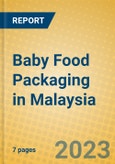The Baby Food Packaging in Malaysia report offers insight into key trends and developments driving packaging across the category. The report also examines trends and prospect for various pack types and closures: metal packaging, rigid plastic, glass, liquid cartons, paper-based containers; flexible packaging.
Product coverage: Dried Baby Food, Milk Formula, Other Baby Food, Prepared Baby Food.
Data coverage: Market sizes (historic and forecasts), company shares, brand shares and distribution data.
Why buy this report?
- Get a detailed picture of the Baby Food Packaging market;
- Pinpoint growth sectors and identify factors driving change;
- Understand the competitive environment, the market’s major players and leading brands;
- Use five-year forecasts to assess how the market is predicted to develop.
Table of Contents
KEY DATA FINDINGS2023 DEVELOPMENTS
- Folding cartons and flexible plastic the dominant pack types in baby food
- Glass jars dominate prepared baby food packaging, but aluminium/plastic pouches gaining share
- The 150g and 250g sizes are most popular in dried baby food
- The 650g pack size is expected to remain most popular in powder milk formula
- The 110g size will continue to dominate prepared baby food packaging








